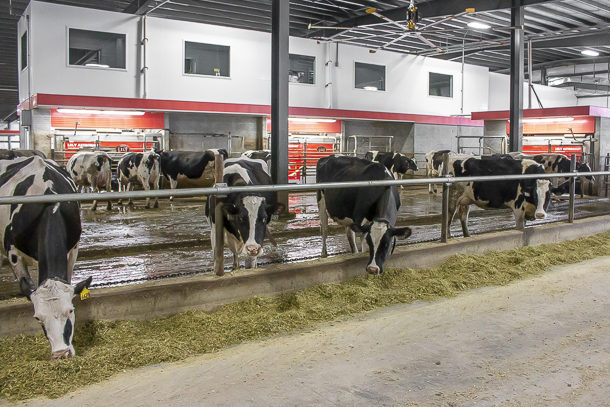Should this cow stay in the herd or should she find a new career? Robots don’t lie. Let their data help you decide.
Good cows are good cows no matter where you find them. Having the information to find them is the key. That good cow in the parlor? You know the one; she consistently averages 120 pounds of milk per day over the course of her lactation. You also know her as the cow that takes 25 minutes to milk out. The problem is: She’s impacting the other 14 cows in a double-15 or the other 39 cows in a double-40. You get the picture. This same cow in a robot dairy is only impacting herself.
Automated milking systems have gained traction in North America. What was once a new and relatively untested way of harvesting milk and managing cows is now a proven milking and management system with tremendous upside potential. These systems target nutrients to cows based on parity and production level. Likewise, the availability of the milking system, tuned to each cow's individual needs, is enabling her to reach her true genetic potential.
As dairy producers continue to refine their management techniques in automated milking systems, their thoughts often turn to the type of animal that best suits these systems.
Despite the intriguing description, the “robot cow” is not the latest piece of technology to come out of Silicon Valley. Rather, a cow in a robotic dairy is in optimal health, at peak production and requires minimal human intervention. These trouble-free cows calve easily, have no metabolic issues during their transition or peak lactation periods, they cycle and breed easily, and repeat the process over several lactations. Additionally, these cows stand and move easily throughout the barn, move to milking robots with vigor and are typically aggressive eaters.
Does this differ from a conventional herd?
The data says no, there is not a lot of difference between the two. Yet beyond the traditional traits like milk production, component levels and conformation traits, milk flow rates have great impact on a cow’s ability to make efficient use of her time in a robot. The ability of a robot to harvest milk is directly proportional to the cow’s ability to make the best use of her time while she is in it. This does not mean we need to focus on milk speed. It does mean we need to balance her need to be milked with the need of the machine to harvest milk from the rest of the herd. When those parameters are in balance, we’re getting the most from the robot and maximizing the cow’s genetic potential.
The dairy cow of today bears little resemblance to her ancient predecessors except in one specific way: She is hard-wired to produce milk to feed her calf. When milk is harvested cleanly, gently and completely, the cow knows she must keep producing for her calf’s needs. Conversely, an incomplete harvest or a milking based strictly on minutes spent being milked will trigger the cow to dial it down and prepare for next year’s calf. Here too, the truth is in the data.
How can we gain maximum efficiency?
Well-attached udders with proper teat placement make easier detection for a robotic milking arm. Udder Composite traits are a useful guide when selecting for a robot herd. Sound feet and legs enable a cow to make frequent trips to a robot or the feedbunk. Feet and Leg Composite traits make an excellent guide here as well. Sire Conception Rates and Daughter Pregnancy Rates are useful tools for reproductive performance. The list of useful trait information goes on and on.
Currently, the USDA is performing a milking speed evaluation for one of the boutique dairy breeds, and the conclusion can be made that a milking speed evaluation will be available for all dairy cattle breeds at some point in the future.
Breed associations provide genetic information and services that assist dairy producers in their genetic improvement efforts and provide guidelines and associated ranking systems specific to those breeds.
These breed associations gather information directly from dairy producers as well as allied industry members to try and determine which traits will be financially important 10, 15, even 20 years in the future. They are to be commended for the significant improvement in production, reproduction and health traits that have been achieved in the last 20 years. Dairy producers can use this information with a high degree of confidence, and the results will yield a trouble-free herd. Connect with the dairy breed leaders and allied industry representatives. Tell them which traits matter to you. Traits specific to robot cows are likely the next evolution in dairy cattle genetics.
What can producers do today to make sure they find the right cows to use as the foundation for their future? It’s all in the data. With a finite number of hours in the day, the efficiency of individual cows is more important than ever. With the advent of robotics and their associated data, producers have greater access to high-quality metrics, allowing them to create more efficient breeding programs.







